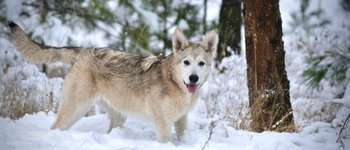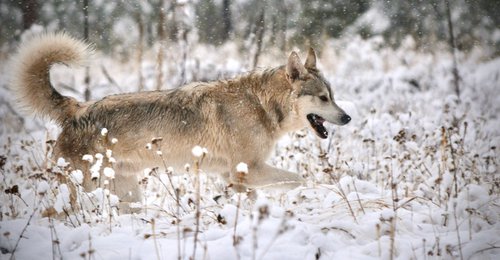Loss is Never Easy
By Jennifer Stoeckl, MAT, Nov. 13, 2020
Today, the American Alsatian Facebook page received a detailed negative review of the breed from a former prominent member of our American Alsatian Owners group. The painful review reminded me of how very difficult it can be to stand firm on clear principles in spite of how others may feel about them. It is never easy to hear negative feedback from someone who feels hurt regarding a particularly deep wound.
The remembrance of that person's pain dropped a dark shadow on an otherwise peaceful day. The pain and disappointment a person feels when their dog must pass much too soon does not always fade easily. It can take time to quell the anger inside that one feels for the beloved furry friend no longer sitting by one's side. I, myself, have felt this deep cut of the heart many times as a breeder and I sympathize in earnest with the owner as he works to stitch the pieces of his heart back together.
Although this particular review tore at my spirit, it also presented an opportunity for me to stand back and reflect on the big picture; why the Dire Wolf Project is here and why we do what we do. In the following paragraphs, I would like to address some of the concerns in today's review and reflect on my own responsibility within the breed to help owners understand the reasons behind our work so that they can clearly share the Dire Wolf Project's vision with others should it be warranted.
First of all, the American Alsatian dog owner described a concern that the Dire Wolf Project does not share accurate health statistics and actively covers up prominent health issues in order to hide the truth from its members and potential owners. This particular concern has been touted by many others outside of the breed, especially from those frequenting dog groups on various social media sites. It is not a new concern, but hearing it from an American Alsatian owner is disheartening and means that we have not done enough within our own groups to harbor transparency and honesty. I take full responsibility for this, as I have single-handedly kept the health database over all of these years, working with Lois, our founder, to make sure it is accurate and honest as we can possibly be. The hallmark of our breeding program is working to eliminate health issues within the breed and we cannot do that it we are not accurate and honest in our reporting of the health issues that have plagued the breed. I know that I have been as honest as I can be, never intending to neglect any health issue, however, it has been pointed out that one must trust us in order to believe in the health database that has been put together. Perhaps an oversight committee within the group might help pull in others to make sure that my eyes aren't the only ones monitoring the health database.

This leads another concern presented in the review that denotes the idea that the breeders within the Dire Wolf Project do not adequately health test our dogs. They namely feel that without formal third-party hip/elbow scoring data at two years old on each and every dog bred within the program that breeders cannot possibly know if we are breeding bad hips and/or elbows. They also want formal third-party proof of eye and heart health, as well. This belief stems from a false understanding of the difference between health prevention model breeding as opposed to health elimination model breeding. I wrote an entire book devoted to explaining the fundamental difference between the two and why Dire Wolf Project breeders are health elimination model breeders, but I must also admit that we could do a much better job of depicting the differences and reiterating them on a more consistent basis within our groups and on our sites. Unfortunately, most of our writings on the subject have been buried on the various Facebook group sites over the years. The good news is that since the Dire Wolf Project's recent website update, we now have the opportunity to blog/archive our writings so that we can refer to them going forward, which I will be working on doing over the next year and beyond.
A further concern from the review had to do with inherited temperament, since his dog was found to possess all of the symptoms of rage syndrome. The point was raised that because we crossbreed on working stock that our dogs could not possibly have a consistent non-working dog temperament. Again, this is a concern I also hear in dog chat groups, but to hear it from an owner is disappointing. Particularly unnerving was the idea that the owner mistakingly had that we promote our dog breed as having a set non-working dog temperament that we do not remotely live up to. The knowledge that an owner shares this concern with those who do not know our breed also means that in some degree, we have not been able to clearly educate our owners that the inherited temperament in our dogs is not yet consistent, especially those crossbred dogs that enter the breed. Although it is written in many places scattered around the Internet and we regularly write about the differences our dogs pose in inherited temperament, the message has not been able to reach every owner. It is not our intention to deceive. If some owners are under a fantastical notion that American Alsatian dogs somehow transcend dogdom and do not possess typical dog personalities, we must work to remedy that notion, yet continue to be as truthful as possible. While many of our dogs do, indeed, fit the non-working standards of our inherited temperament ideals, some do not. In particular, those dogs closest to a most recent outcross.

The third major concern presented by the reviewer was the fact that many of our American Alsatian dogs do not yet resemble wolves in any way. This is one of the biggest concerns shared by outsiders about the breed. It is usually mentioned by those opposed to the Dire Wolf Project that American Alsatian dog breeders have had thirty years to get it right and haven't yet done so. The reviewer chose to take the concern a step further, though, and comment on the fact that the cost commitment for purchasing an American Alsatian DireWolf Dog is much higher than the looks warrant. As I interpret it, the malcontent seems to come from the fact that many of our dogs simply look like mutts of no consequence. Perhaps the reviewer feels that many people may be drawn in by the marketing of the project instead of seeing the reality that our dogs are simply mixed breeds without serious focus, evident by the amount of time that has passed with no real progress made on the overall looks within the breed.
Humans are definitely swayed by a beautiful look and the wolf has captured our hearts with beauty and grace embodied by the wild spirit of nature's majestic world. As an owner, it must be hard to wait year after year, following the project's slow pace. I can surely admire that concern as I, myself, have complained loudly at the snail's crawl we seem to achieve. But, that is another one of those aspects that we cannot compromise on for the integrity of the breed itself depends upon our dedication to health and temperament before any other outward appearance feature of the breed. Reversing a 15,000 year old domestication process in outward appearance, while continuing to shift toward a large non-working dog breed as a whole is not an easy process. I find myself lamenting on the fact that we haven't done a good enough job in this area of educating our owners on that fact.
Too often we choose, instead, to relish in the cute pictures and videos of the American Alsatian dogs shared on our social media groups. And yet, reflecting on the loss of this owner's trust that the Dire Wolf Project is working toward superior health and temperament in the prehistoric wild wolf causes me deep sorrow. In this person's mind, we failed to honor our agreement with him and for that my heart aches to turn back time and give him the information and support he needed.
I am fully aware that no one can please everyone, but this review comes at a time of particular bitter loss for me. A dear friend and breeding colleague suddenly left the Dire Wolf Project to breed on her own. She was one of my closest friends and not being able to share my heart's biggest passion with her has been harder than I could have imagined. Having to say good-bye to such a friendship is a loss I was not prepared to handle and I am shocked at my heart's lingering sadness. The memories we shared, even recently, seem so very distant and dream-like. Now, I must conjure up the courage to write her formal letters of separation on behalf of the Dire Wolf Project. It feels so permanent and final. Perhaps that is how the reviewer felt when he decided to leave the breed's depths and no longer share his life with us. Losing a beloved dog is hard, but losing family is even tougher. Each time an owner leaves the Dire Wolf Project and feels enough concern over our practices that they must write as detailed a negative review as was written today I feel like a part of my family has passed on before I have had a chance to explain how much I love them.
Loss is never easy. Letting go of loved ones takes time and courage to face another day without them. Perhaps American Alsatian owners do not realize just how much Dire Wolf Project breeders care for the families that touch our lives. Take it from me. Each negative review; each American Alsatian owner that leaves our groups dissatisfied; each breeder that learns our unique ways and departs from us with a heart full of confusion and mistrust are mourned. Your lives mean more to us than you know. Your pain is our sorrow. Your heartache is our heartbreak.
Jennifer Stoeckl is the co-founder of the Dire Wolf Project, founder of the DireWolf Guardians American Alsatian Dog Training Program, and owner/operator of DireWolf Dogs of Vallecito. She lives in the beautiful inland northwest among the Ponderosa pine forests with her pack of American Alsatian dogs.